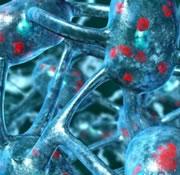 Stem cells can both turn into neurons and help neurons to grow.DAVID MACK / SCIENCE PHOTO LIBRARY
Stem cells can both turn into neurons and help neurons to grow.DAVID MACK / SCIENCE PHOTO LIBRARYHuman stem cell transplants have eased the symptoms of Parkinson's disease in a monkey model of the brain disorder. The study, which brings the prospect of human trials one step closer, hints that stem cells do more than just replace cells — they may help persuade the brain to heal itself.
Parkinson's disease, which affects around 1 in 500 people, destroys nerve cells that produce the chemical dopamine, leading to movement and balance problems. Most treatments attempt to boost dopamine levels through drugs, but the results can be patchy and short-lived. So the hope is that stem cells — primitive cells that can produce many other cell types — may offer a more permanent solution.
In the current study, published in Proceedings of the National Academy of Sciences1, researchers isolated stem cells from the brains of aborted fetuses and grew them into large numbers in the laboratory. The cells were then injected into the brains of monkeys with a severe form of chemically induced Parkinson's disease.
Before the treatment, the animals couldn't walk unaided, struggled to use their hands and were sometimes unable to move at all. But two months afterwards, they could walk, feed themselves and move more normally. "They're not as good as normal monkeys, but the improvement is still dramatic," says team-member and neuroscientist Richard Sidman from the Harvard Institutes of Medicine, Boston, Massachusetts.
Take two
There have been a large number of successful studies showing that human and rodent stem cells can help rats with a version of the disease get better. But the field was hit by a major setback when human trials of transplanted fetal brain tissue in the mid-1990s left some Parkinson's patients with uncontrollable, jerky movements. Since then, a lot of work has gone into culturing and purifying stem cells.
Paul Sanberg from the University of South Florida College of Medicine, Tampa, who was involved in the early human trials, points out that the new treatment works well in extremely ill monkeys, so it may work even better in milder cases or early stages of the disease. And unlike some other stem cells, which have had growth-promoting genes added in or been derived from day- rather than week-old embryos, these cells appear not to form tumours after transplant. That should ease worries about the safety of stem-cell treatment.
Support team
But perhaps most surprising is how the transplanted cells did their job. Only a minority of stem cells turned into dopamine-producing neurons — not enough to replace all the neurons that had been lost to disease. Instead, some of the stem cells turned into astrocytes, a supportive brain cell known to produce neuron-nourishing chemicals. The team spotted a host of large, dopamine-producing neurons in the brains of transplant recipients that weren't directly derived from stem cells. It's thought that stem cells may churn out molecules that boost nerve survival and blood-vessel development, and decrease inflammation and neurodegeneration — helping the host brain to help itself.
"People used to think that stem cells transplants would work by replacing missing cells," says neuroscientist John Sinden from the UK stem-cell company ReNeuron. "But these results suggest they may do more than that. They may actually switch on the brain's own innate repair mechanisms."
ADVERTISEMENT
"It's becoming clear that transplanted neural stem cells exert their behavioural effects through a series of mechanisms," agrees study contributor and stem-cell biologist Evan Snyder from the Burnham Institute for Medical Research, California. "There's a whole network of activity and crosstalk."
The intriguing results mean there is much more basic research to be done before moving to clinical trials, says Snyder.
Visit our cellshelpprimateswith.html">newsblog to read and post comments about this story.
